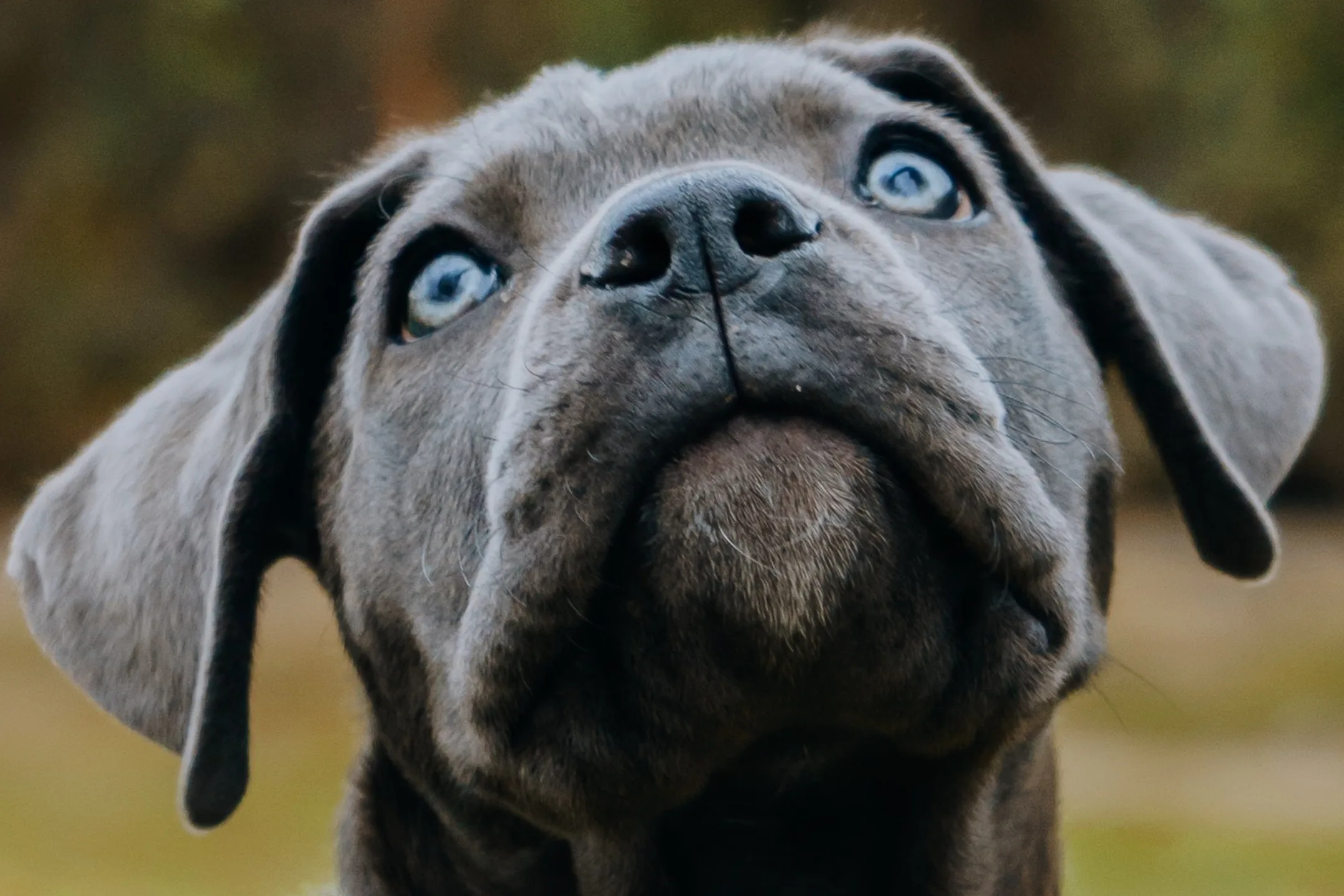You probably already heard about the Cane Corso, but did you know that there is a blue Cane Corso? If not, you definitely aren’t alone. However, there is a lot of controversy surrounding this color variation, because some people believe that they don’t even exist.
There’s no mention of the blue color variation in either the FCI’s or AKC’s breed standards, but there are still breeders that advertise blue Corso puppies for sale.
The confusion about the blue Cane Corsos appears to come from the breed standards that called the Cane Corso’s diluted black pigment grey instead of the more common term — blue.
However, if you still want to learn more about this controversial color variation of the Cane Corso, keep on reading.
What is a Cane Corso?
The Cane Corso is a purebred dog with deep Italian roots. He is believed to be a descendant of the Italian “Mastino Napoletano”. It is proven that already in the 4th century in the south of Italy and Sicily people bred dogs resembling Cane Corsos.
But back then they were called “Italian shepherd dogs”. Also, the Cane Corso was already used by the ancient Greeks and the Romans as a herding dog. Especially on farms in southern Italy, the breed is to this day very popular. Due to his independent way of working, he has been a great help to his people for many centuries.
Despite their intimidating appearance, Cane Corsos are very loyal to their families and treat the people they love and trust very lovingly. They can take their protective instincts carefully from strangers and other animals.
What are the accepted Cane Corso colors?
The American Kennel Club lists black, lighter, and darker hues of gray, lighter and darker shades of fawn, and red as acceptable colors for this breed.
Brindle patterns and black or gray masks that do not extend past the eyes are also permitted. Even a stray white patch is allowed. But tan pattern markings or points, such as those seen in Rottweiler and Doberman breeds, are not.
Not only do different coat colors have a significant impact on the Cane Corso’s overall appearance, but some tints have a shorter life expectancy than others. This is why it’s important to consider the many colors available. We talked more about that in our article ‘How long do blue Cane Corsos live?‘.
Cane Corso blue appearance
Cane Corsos definitely look intimidating. Their serious facial expressions and muscular bodies are a little too scary for some people. Don’t be surprised if other dog owners avoid you and your puppy when you go for a walk.
These dogs have a short, straight, coarse coat that lies firmly on their skin. Their fur is also waterproof, so Cane Corsos are prepared for all weather conditions. When it comes to the color of their coat, don’t expect your blue Cane Corso to be a strumf blue color. As we already explained, they are a light grey color. Although they may not be soft and silky if you pet them like other dog breeds, they do not require expensive trips to the groomer.
Full grown blue Cane Corso size
Blue full grown Cane Corso dogs are large in every way. They have thick, muscular legs and a wide torsos to carry their big heads high in the air. Some of them get their ears cut off, while others have adorable floppy ears. This is often called ear cropping, and it’s illegal in the United States. However, if a Cane Corso is imported from Europe, especially Italy, chances are that he will have cropped ears.
These dogs are massive and usually weigh between 90 and 120 pounds. They can be 24-28 inches tall, which further emphasizes their bulky appearance. Just like with any other breed, the blue female Cane Corso is slightly smaller in size than the male counterpart. The blue Cane Corso female is 23 to 26 inches tall and weighs 85 to 99 pounds. Cane Corso blue female dogs are also faster and more agile than male ones.
Blue eyed Cane Corso
Did you know that blue Cane Corsos also often have blue eyes? Why? Because the blue Cane Corso colors are the product of a recessive dilution gene, that causes the lack of melanin. This won’t only cause their coat to be lighter than normal and diluted, but also their irises. That means that blue Cane Corsos may also have blue eyes, which is incredibly rare in this mastiff breed. However, you have to be aware that this is the product of a genetic mutation. That means that is also comes with certain risks, which is the reason why reputable breeders don’t breed blue Cane Corsos. Blue steel blue Cane Corso colors aren’t recognized by the AKC, and blue eyes and a light blue-ish gray coat color are considered to be flaws.
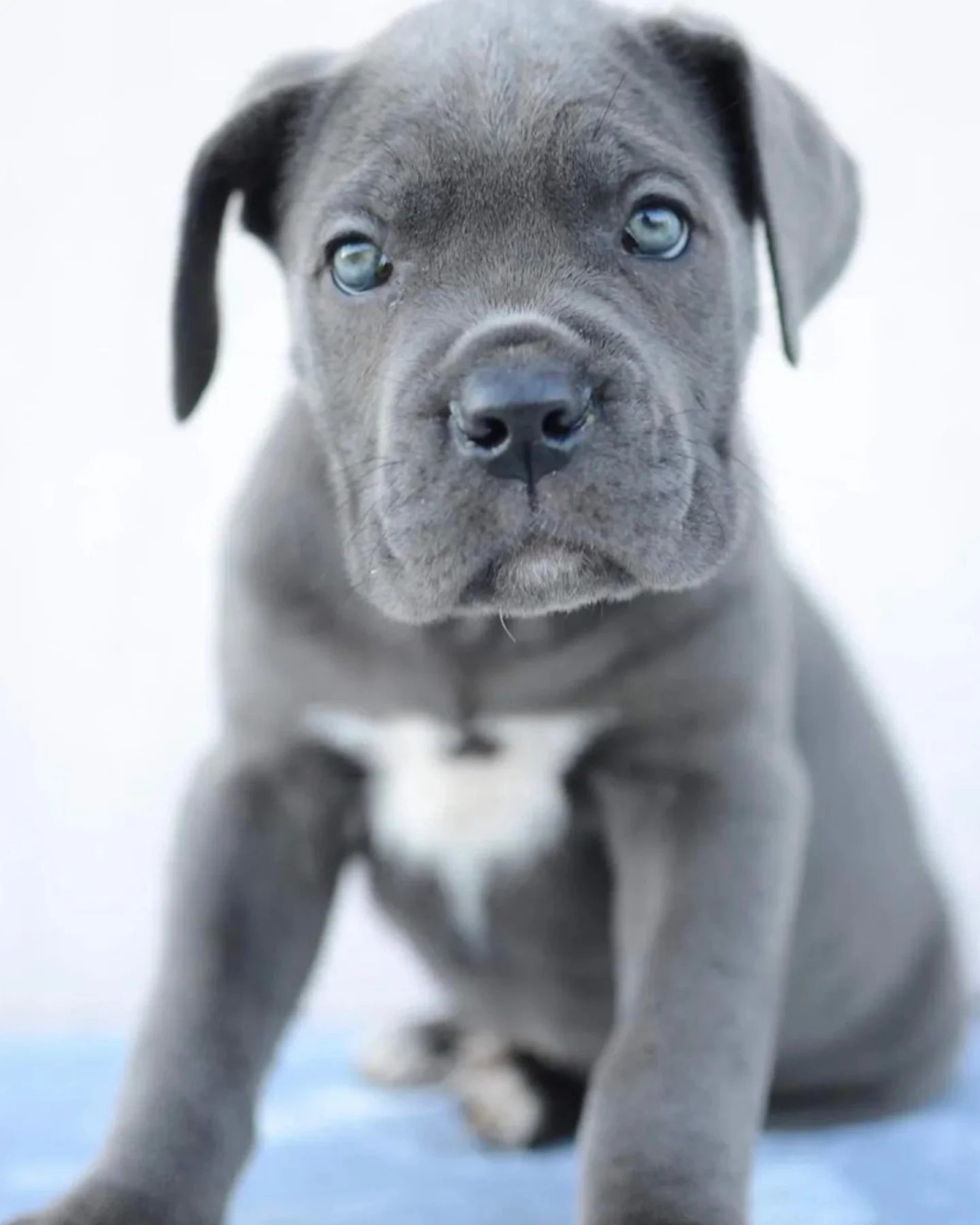
Source: Instagram (donhelnedo_kennel)
Blue nose Cane Corso
You might also hear the term “blue nose Cane Corso”. This isn’t anything fancy and it’s pretty self explanatory. While most Cane Corsos have black noses, those with the genetic mutation that cause the dilution gene, have a lighter, “blue” colored nose. Again, don’t expect a strumf blue color. Instead, you should expect a grayish blue tint to their nose. As we have already explained, these dogs are generally lighter than the average Cane Corso. From their coat, ears, eyes, and nose.
Blue Cane Corso personality and temperament
These dogs are very serious and hardworking animals that don’t play around. You will never see them messing up – they are constantly on the alert and ready to protect their families. Any fooling around would distract them from their job.
If they have nothing to do, they quickly get bored and become destructive. Their busy heads must remain busy, otherwise, they will dig massive holes in your garden and tear up your favorite shoes.
Because these dogs are so hardworking, they have a very cool, calm, and collected demeanor. They are often referred to as professional bodyguards because nothing really triggers them too much.
These dogs have a self-confident charisma that will amaze everyone they meet. Despite all the energy contained in their large bodies, they can keep themselves under control and act gracefully at any time. We talk more about their personality in our article ‘Are Cane Corsos good family dogs?’.
These dogs also have a loving side reserved for their family members. Their extreme love for their families can lead to them developing separation anxiety. They can be very stressed if they are left alone, and can thus chew or dig. It is important to recognize this behavior at an early stage in order to correct it.
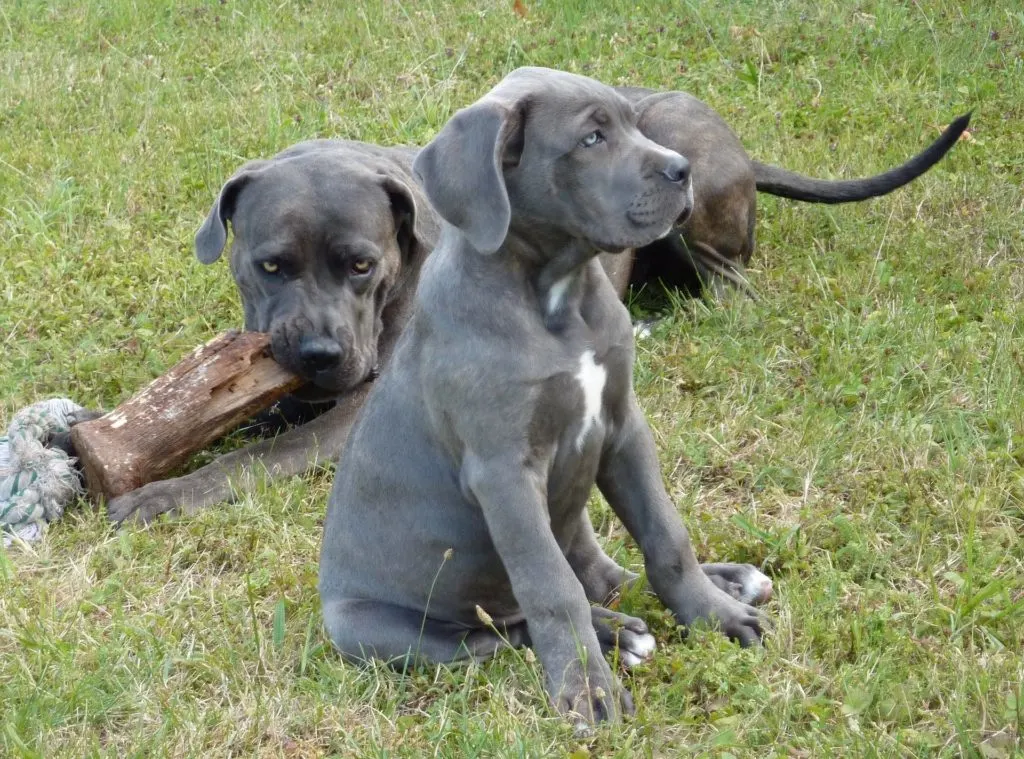
Early Socialization
As well-rounded as these dogs are, you still have to start early socialization. Because they are so careful and alert, they could have a hard time around strangers. But not only strangers, other dogs as well. Start when your dog is still a puppy, basically as early as possible. At first, always supervise your dog when he’s in the company of other dogs.
Early socialization will also help your dog control his urges to be overly protective. They are very suspicious towards strangers and this can very easily become a problem. This will also teach them how to act and react in various other social situations.
Exercise requirements for blue Cane Corso dogs
Cane Corsos need a lot of exercise every day, so be prepared for an active lifestyle. These dogs were bred to work, hunt, and protect. They have infallible endurance and seemingly unlimited energy.
Daily walks will be a good start – but walks will not make it alone. Hikes, bike tours, and runs are great additions.
Grooming the blue Cane Corso dog
Grooming a blue Cane Corso blue is probably the easiest aspect of caring for one of these giants. They must be brushed 2-3 times a week to minimize shedding. During the shed season, you most likely want to brush them daily.
When it comes to bathing them, a bath once a month is enough. In addition to grooming, the teeth must be brushed 2-3 times a week. Her ears must be checked weekly for wax accumulation and her nails must be cut off every month.
Health issues and life expectancy
Overall, the Cane Corso is a fairly healthy breed. They have some health problems that can possibly affect them, but their strong personality seems to ward off most health problems.
One of the most common diseases is hip dysplasia, due to their active lifestyle. They run around a lot and strain their robust bodies a lot. Therefore, pay close attention to signs of pain or discomfort.
Their sagging eyes also cause them to develop anomalies with their eyelids. Check their eyes frequently and alert your veterinarian if something seems unusual. This will help prevent most dog eye problems.
As the gray Cane Corso’s coat coloration is produced by a “recessive mutation in the melanophilin (MLPH) gene,” it means these dogs are more vulnerable to skin problems such as mange and Color Dilution Alopecia (CDA).
Finally, you have to pay attention to bloating. Feeding your dog smaller meals, spread over the day, can help counteract this.
The life expectancy of a blue Cane Corso is approximately 9-12 years.
Blue Blood Cane Corso (Alapaha Blue Blood Bulldog & Cane Corso Mix)
The Blue Blood Cane Corso is a cross between an Alapaha Blue Blood Bulldog and a Cane Corso dog breed. In terms of size and temperament, both parent dog breeds are fairly similar. The Alapaha is a river that originates in Georgia’s south-central region.
Dog Alapaha, also known as the “Otto,” was the result of a line of dogs produced by Papa Buck Lane. The Alapaha was bred for protection and friendship, and its origins can be traced back to the English Bulldog. It is supposed to be a devoted and protective family member.
The Blue Blood Cane Corso hybrid is an even rarer dog breed than the Alapaha. The Cane Corso Italiano dog breed was developed to hunt big prey, particularly wild boar. The American Pit Corso dog breed is known for being calm and trainable.
The American Pit Corso dog breed is known for being a delightful companion, requiring only minimal care and modest exercise. Because the Alapaha Blue Blood Bulldog and the Cane Corso have so many qualities, it’s not unreasonable to expect the Blue Blood Cane Corso to be a perfect blend of the two parent breeds.
Are Blue Cane Corsos Rare?
The blue Cane Corso is often mentioned either online or by dog lovers. But what is all the fuss about? But no breed standard includes a blue Cane Corso. The color gray is most likely what people are referring to when they say blue.
It’s not a major concern if the breed’s color is incorrectly labeled, but a breeder who brands his Cane Corso puppies as blue-colored should be an immediate red flag. This indicates that the breeder hasn’t bothered to search up the breed standard, which is a must for conscientious breeders.
Ask these questions of your breeder to expose backyard breeders that are attempting to dupe you into purchasing a puppy that is likely undersocialized and lacking in health certificates. Also, stay wary of anyone who refers to shades of red or fawn as “yellow” or “golden” puppies.
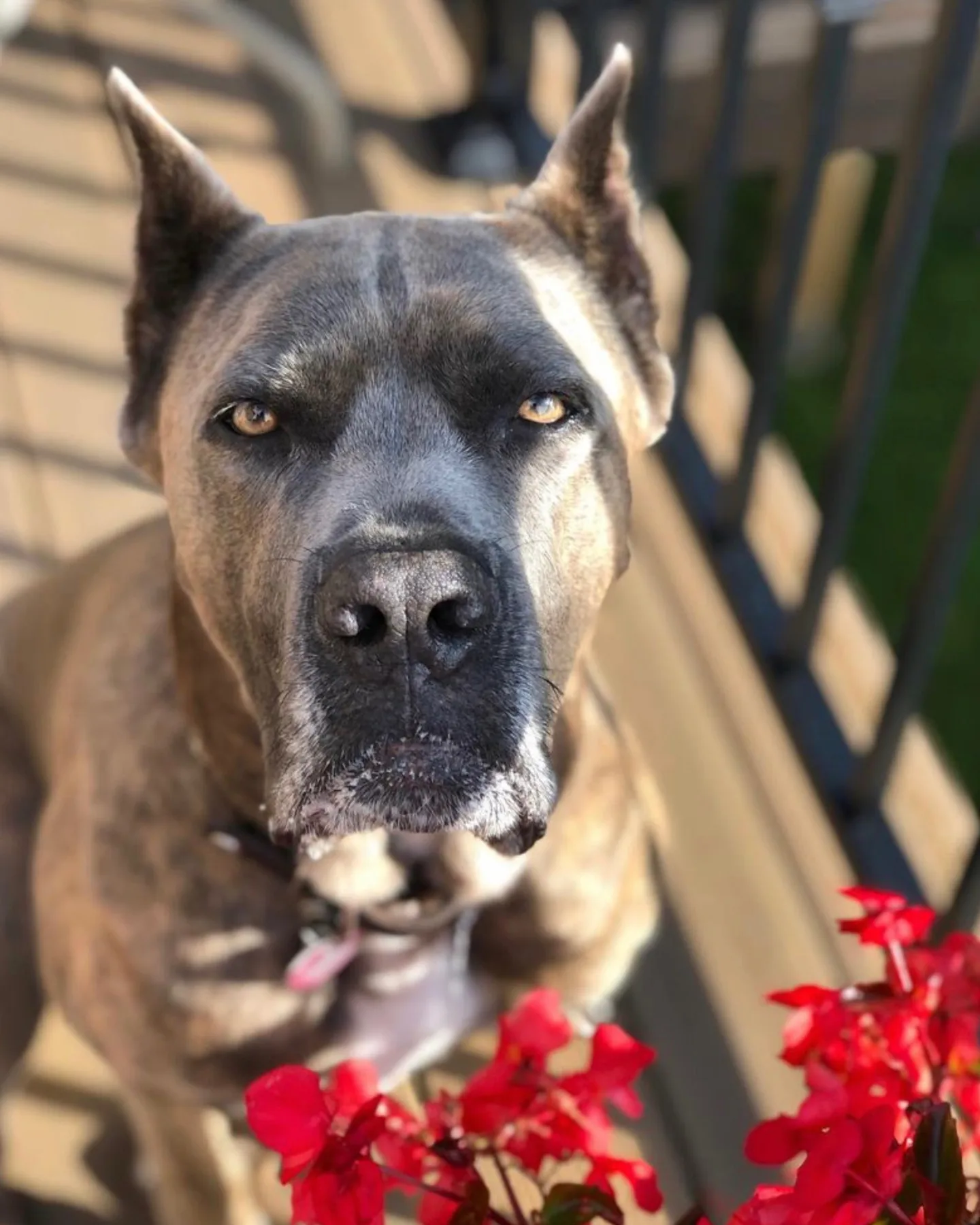
Source: Instagram (@lolacanecorso)
How much is a blue Cane Corso puppy?
Typically, the cost will be between $900 and $2,000. This is for a dog that has a solid pedigree and has passed health testing but isn’t quite ready to show. This doesn’t mean there’s something wrong with them; it only means they don’t meet the breed standard for showing.
Show-quality ones are usually sold for $2,500 to $4,000, but they can go as high as $8,500. (if they have a superior pedigree which drives up their price). A pedigree assures dog owners that their pet is purebred and descended from a reputable line.
There will also be the ongoing costs of keeping them in show-quality condition. As a result, breeding and purchasing a show-quality Cane Corso is more expensive. We go into more detail about this topic in our article ‘How much is a blue Cane Corso?’. Check it out on our home page The Goldens Club.
Blue Cane Corso puppies: Where to buy a blue Cane Corso puppy
When buying a puppy, you always have four options available. No matter if you are buying Cane Corso puppies blue, black, or brown colored. Those four options are reputable breeders, animal shelters, backyard breeders, and puppy mills. The only two options that we would ever suggest are reputable breeders and animal shelters. Puppy mills and backyard breeders don’t follow ethical dog breeding practices. Instead, they mass-produce puppies, without making sure that they are healthy or have good temperaments.
When it comes to animal shelters, Cane Corsos are often given up for adoption. So it is possible to find a Cane Corso at an animal shelter. However, most likely you will end up with an adult dog. When it comes to reputable breeders, we would suggest looking out for AKC-registered Cane Corso breeders. But because blue Cane Corsos aren’t recognized by the AKC, don’t expect to see this color available often.
What is a blue King Cane Corso?
When you’re looking for blue Cane Corso puppies, you might come across blue “King” Cane Corsos. But what are they? Well, the answer is quite simple. Blue Kings Cane Corso is actually the way Cane Corsos form a specific, well-known US based breeder are called. Blue Kings is located in Atlanta GA, and they have produced multiple dog show and working dog champions. They have hundreds of happy costumers, and health test all of their puppies. Blue King Cane Corso dogs are of an amazing bloodline, and you can be confident that you are getting a healthy puppy. If you are interested, you can check out their available puppies on their website.
Did we spark your interest in rare colored Cane Corsos? Then why not mention a few more…
Black Cane Corso
Imagine how shiny and elegant the smooth and short coat of a Cane Corso would look like in black. Pretty majestic, right? A fully black Cane Corso that meets the requirements of the American Kennel Club AKC is pretty rare to find. So don’t be surprised if there babies will be pretty pricy if you do. The black Cane Corso can have a white patch on the chest, throat, chin, backs of the pasterns, and toes. If they have white spots anywhere else, they don’t fit the standard.
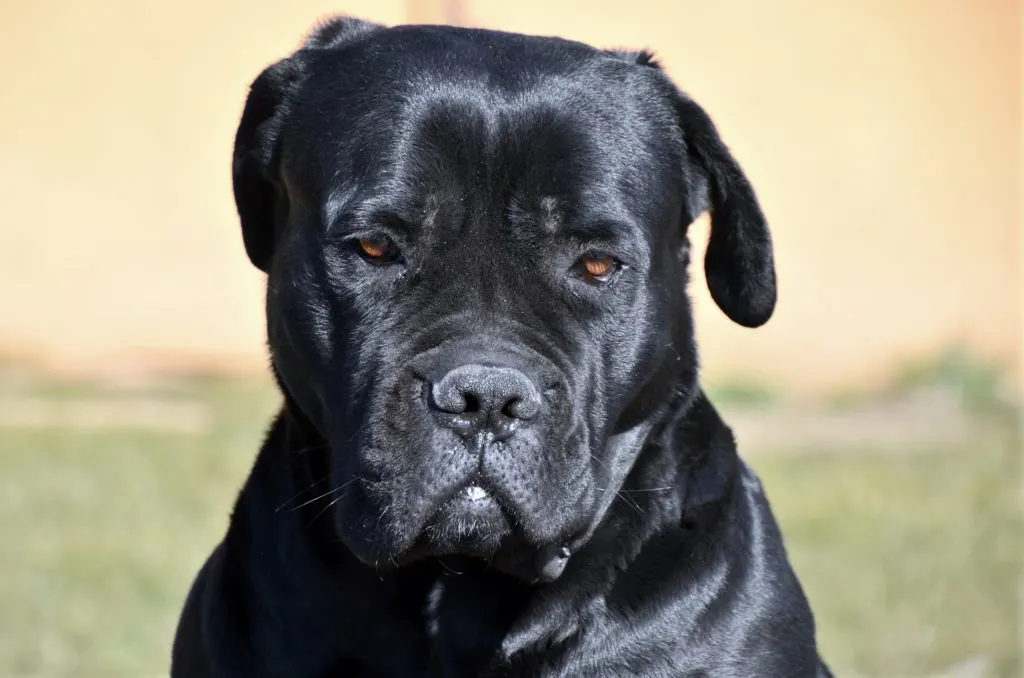
A completely black Cane Corso looks a lot like a phantom. His appearance is so appealing to many people that he’s often called the most popular Cane Corso of them all. Otherwise, his personality and maintenance levels are the same as with the other Cane Corsos.
Because black is a dominant gene, two black Cane Corso will always produce black or gray puppies unless both parents have the recessive red/fawn gene, which is extremely unusual. So the highest chances are that two Black Cane Corsos will produce gray puppies.
Formentino Cane Corso
The Formentino Cane Corso are so unique looking dogs that some people even believe that they are a separate dog breed. However, that is not the case at all. They are actually just another rare color variation.
The word “Formentino” is Italian and is used to describe the color of fermented wheat. The closest thing that we could describe it as is a diluted, faded out fawn color. The Formentino Cane Corso in addition to that has a blue nose and mask in addition to gray patches over his shoulders and back.
Just like other diluted color variations, the Formentino Cane Corso is also prone to different skin conditions. He has a bit of a lower life expectancy than darker colored Cane Corsos. The Formentino Cane Corso lives about 8 years, while brindle colored Cane Corsos live about 10.
Chestnut Cane Corso
The Chestnut Cane Corso is similar to the black brindle in appearance but is significantly less common. The Chestnut Cane Corso, like the gray brindle, has a brown or red base with reddish-brown stripes.
Because “at least one gene important for coat color is situated on a sex chromosome,” Chestnut Cane Corso is more difficult to breed for than some of the other hues. The color of a puppy’s coat is impacted by its gender and the color of its parents.
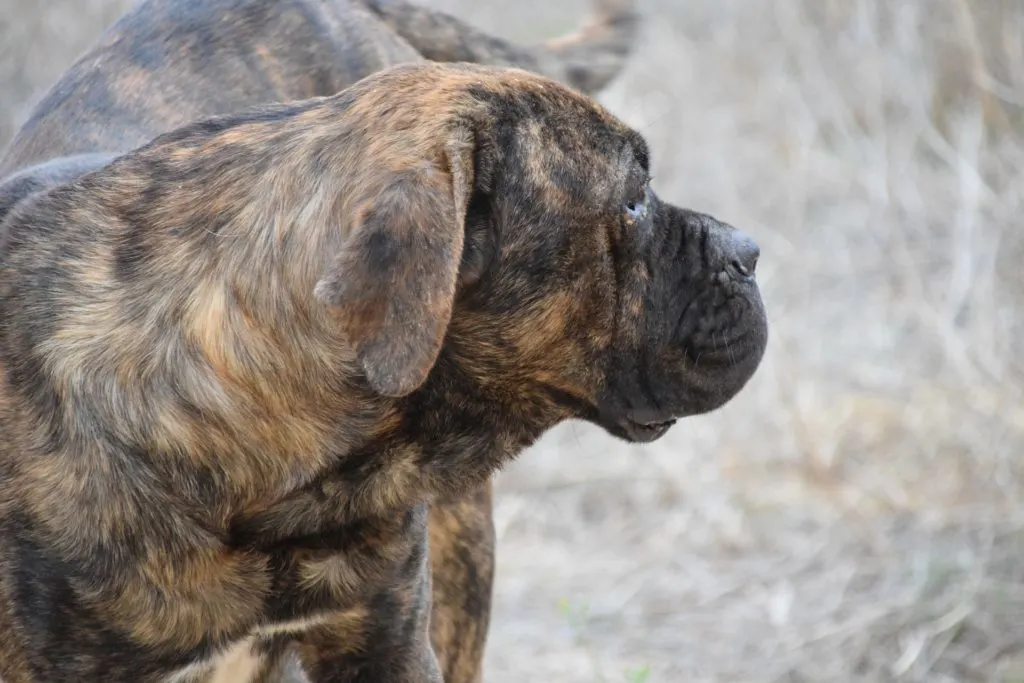
The stripes can vary from mild to heavy, just like any other brindle Corso, and more diversity has been seen in recent years as the consequences of the Cane Corso’s 1973 resurgence have begun to manifest.
Blue brindle Cane Corso & blue merle Cane Corso
Brindle is more of a pattern than a color. Therefore, the blue brindle Cane Corso puppy has the same blue-ish grey base color, with a brindle pattern on top. Brindle patterns are black stripes, often called “tiger stripes” that can be found in some dog breeds, but also other animals such as pigs, cats, and horses.
The Cane Corso blue brindle puppy has a recessive gene, causing this unusual coat pattern. This color is pretty popular in the Mastiff community, so don’t be surprised if Cane Corso blue brindle puppies are even more expensive. This “tiger color” makes the dog look even more intimidating, which is something many Cani Corsi owners desire.
Another pattern variation is the blue merle Cane Corso. Merle is another coat pattern, and it can often be an indication that your Cane Corso isn’t purebred. The merle pattern is more common in cattle dogs, such as the Australian Shepherd and Catahoula Leopard Dog. But it isn’t normally found in working dog breed.
What is the rarest color of Cane Corso?
The most common color for this breed is black, according to Evzen Korec’s study “Inheritance of coat color in the Cane Corso Italiano dog.” All of the remaining colors in the breed standard, on the other hand, are not considered rare because they can be found at certified kennel facilities.
The following is a list of the rarest Cane Corso colors:
- Liver
- Formentino
- Isabella Fawn
Because these tones are the product of recessive genes, they are so unusual to come across They aren’t a good way to identify crossbreeding because it can happen without genetic modification.
However, many breeders are breeding Cane Corsos these days in order to acquire these unusual hues. They then sell the puppies for exorbitant prices, despite the fact that they are fully aware that they may carry congenital disorders.
Conclusion: Should I buy a blue Cane Corso?
After learning everything that was about the blue Cani Corsi, you might be wondering if this is the right puppy for you? As beautiful as these dogs are, we would say that the answer is no. Reputable American breeders of Cani Corsi won’t breed this color, because the dilute gene associated with it is considered to be a flaw and cause different health issues like alopecia. The color blue can only be found in dogs with the dilute gene, so you are risking getting an unhealthy puppy.
If you want a lighter Cane Corso color, then consider getting a fawn Cane Corso instead. You can find an amazing breeder that follows the original breed standard and tests their puppies for different health issues. Try to meet the puppies and see which one would be the best match for you, and who has the potential to be your future best friend. Cane Corso dogs are protective, loyal, and strong, and anyone who can handle their strength would be lucky to own one.

